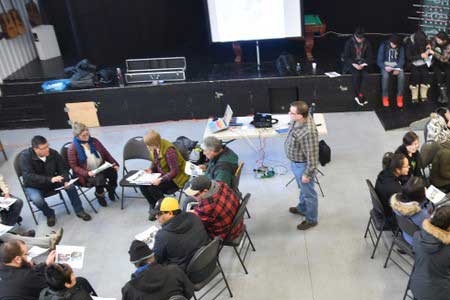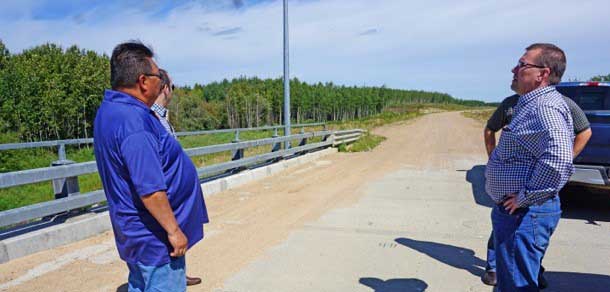Engagement before exploration. That’s the secret to Mark Liskowich’s success. Liskowich’s geology degree enabled him to secure a career in mining and exploration, and eventually with SRK Consulting where he has served as a principal consultant for the past 12 years. But its his people skills and social interactions that allow him to achieve favourable outcomes within that role.
Engaging Communities
Liskowich’s main area of work centres around environmental mine management (tailings, waste rock and contaminated water), permitting and social licensing and closure for mining projects. Through phone calls and face-to-face meetings, Liskowich engages community and First Nations leaders and stakeholders whose neck of the woods may be impacted by proposed mining projects and subsequent outcomes from those projects.
“By trade, I’m a geologist. But (people skills) is something you gain through experience and it’s a very big part of what I do,” Liskowich said from his SRK office in Saskatoon.
“Working and living in northern Saskatchewan is probably where I got the foundation for it. It’s being involved with First Nations communities and understanding their needs and their concerns. It’s about going into every meeting with an open mind. There’s a significant cultural difference between European culture and Aboriginal culture and being able to recognize those differences goes a long way to helping to bridge and develop those relationships. Basically, it comes down to respecting people and treating everyone as equals and listening.”
Career Transition
Liskowich has been involved with environmental management of the mining industry as far back as 1992. His career began with the provincial government as a mines inspector in northern Saskatchewan before he transitioned to a role as manager of the Northern Mines Monitoring Secretariat – a communications conduit between regulators and the uranium industry and northern communities. He worked in this role for several years, with a focus on uranium mining. Following that, he served for five years as the head of technical and environmental services for the Giant Mine remediation project in Yellowknife.
“I chose to get into consulting at that point,” Liskowich said. “I joined SRK with the intent of opening an office in Saskatoon. SRK, as a company, had done a lot of work in Saskatchewan over the years and felt it was time that we had a physical presence in the province.”
What sparked that change from geology to environmental management? People. And a better understanding of how the industry operates.
“I felt it was important that people managing the environment within the mining space had some understanding of mining and exploration,” he explained. “That was my main driver. If you’re going to regulate an industry you should have a little bit of understanding of it.
Building Relationships
 Saskatchewan is a global hotbed for mining. According to a survey from the Fraser Institute, which measured the attractiveness of a jurisdiction for mining, Saskatchewan landed the top two spots in the world – with uranium and potash leading the way. The analysis looked at a mix of things such as mining reserves, public policy, ease of permitting. Even with commodity prices softening, investment generated by mining is significant and important to any jurisdiction.
Saskatchewan is a global hotbed for mining. According to a survey from the Fraser Institute, which measured the attractiveness of a jurisdiction for mining, Saskatchewan landed the top two spots in the world – with uranium and potash leading the way. The analysis looked at a mix of things such as mining reserves, public policy, ease of permitting. Even with commodity prices softening, investment generated by mining is significant and important to any jurisdiction.
But before a drill hits the ground, relationships need to develop. What is the environmental impact of the proposed project? The socio-economic benefits? These questions and several others are addressed by Liskowich and his team when they meet with community leaders and stakeholders.
It starts with a phone call. He’ll contact the leadership of the community or the First Nation and request an opportunity to meet to tell them about the project. Liskowich requests that they be a part of the ongoing process to move the project forward. From there it moves to a broader audience like community interest groups.
If handled properly, these bonds usually last the lifetime of the project – development, design, construction, operation and closure. As well, there’s opportunity for stakeholder engagement in all phases.
“There has been a lot of work in northern Saskatchewan in the last 20 years with respect to mining and engaging communities, much more so than in other jurisdictions in other parts of Canada,” Liskowich continued. “We have a very strong record of that here. If there was a flaw in that, it’s that we’re not engaging the communities early enough. I hear from communities and they tell me more often than not we come in after we’ve started the mine and after we submitted our applications. They would have liked to have been at the table with us when we started so they can be prepared and bring their community along with the project.
“Because it’s people dealing with people, it takes time. You have to develop a relationship with communities, with individuals, and if you’re able to develop those relationships early in your process for a new project, nine out of 10 times you’re going to get acceptance of that project by those groups. They’re allowed to move along with the project and be a part of the successes of the project. They’ll also have ownership of some of the controls that are involved with the project in order to protect their interests – whether they be environmental or socio-economic.”
That’s where Liskowich and his social interactions come into play. Phone calls and in-person meetings dominate much of his preparation. While Liskowich understands that social licensing is a common term, the definition may change from group to group. His interpretation of a social license is simple.
“It’s a positive relationship, a partnership, agreements to work together… between proponent and stakeholder,” he said. “It’s based on a relationship that is founded on trust. It typically has, in mining space, commitments from the proponent to work with the stakeholder groups to, as the project benefits, so do they.”
Overcoming the Past
There have been cases of mining companies with a dark past. This, propped up by negative media attention, makes Liskowich’s job challenging at times. Some community groups are more difficult to consult with than others – though the commodity makes a difference, as does the location.
“As an industry, I don’t think we have done a great job of promoting the positives of mining,” Liskowich said. “The press that you see and read on mining seems to be about the mistakes or the accidents over the years. Mining is no different than any other industry – if there’s a townhall meeting, typically, the majority of the people who come are the ones who have an axe to grind or have something to say against the particular project. You have to be ready to deal with people who come in with a negative approach or negative opinion. Ideally, in order to overcome that, you go into the communities as early in the process as possible.”
Liskowich explained there wasn’t a lot of emphasis placed on the environment in the early days of mining. A number of sites throughout the country are lasting reminders of poor management from the past. But in some cases, the legacy still persists.
Steps have been made to improve the industry’s reputation. For example, water is now treated before it is discharged so it’s acceptable to the environment. And wastes are managed in engineered facilities so they’re contained.
“There are some historic scars on the industry,” Liskowich said. “(But) we have grown. In Canada, our legislation and our regulations for the protection of the environment are arguably second to none in the world. Other countries around the world use it as a benchmark.”
“I think as an industry we have grown over the years. In my career, I have seen a change in the level of involvement of First Nations and non-First Nations stakeholder groups. The regulations have changed, but also the level of understanding within the industry has changed to the point where industry as a rule believes it’s important and therefore make the effort to involve First Nations communities and non-First Nations communities. It’s not challenging. It just takes a concerted effort to do it.”
Looking Ahead
It’s no secret mining is critical to the economy of Saskatchewan and Canada. Liskowich feels proper environmental management, environmental safeguards and maintaining public acceptance will allow the mining industry to continue.
“You can mine successfully, and at the same time protect the environment, and at the same time protect the interests of the public,” he said.
As for the future of mining, Liskowich sees it as strong.
“We need to continue working to reduce potential impacts of mining operations, whether it be a change in footprints, more detailed engineering in terms of waste management or more innovative thinking in terms of new and less-damaging extraction techniques,” he said.
“We’re continuing to always push the envelope to try to make things better environmentally and still provide the commodities that the global populations need.”
